Turtles are an excellent pet choice. They are often preferred because they are easy to care for, quiet, less demanding than cats and dogs and still more interactive than fish.
Turtles live longer than most pets, and they make a great choice if you are looking for a long-term companion.
Besides living for many years, turtles can also grow very big. A bigger turtle can be harder to manage than a small one.
Turtles that grow very big also means that you would need to keep changing the tank size to accommodate the growing turtle. This can be stressful and costly.
The good news is that there are turtles that stay small, and there is a variety to choose from. By getting a small turtle, you will manage to keep your expenses low.
You don’t want to get to a point of letting go of your turtle because you no longer have enough space for it.
There are over 300 turtle species, and choosing one that stays small might be a demanding task.
Below, we have made the decision easier for you by having an in-depth look at the top turtle species to consider if you are looking to get a pet turtle that stays small.
1. Mississippi Mud Turtle
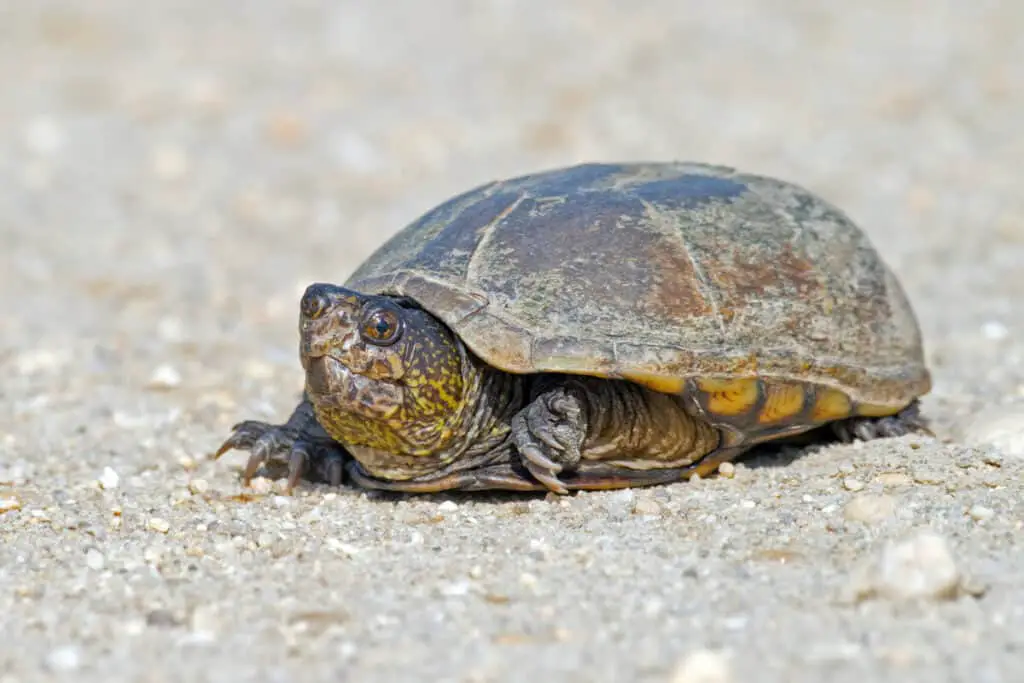
Mud turtles are a great choice for beginners because of their size and affordability. They are also easy to maintain and do not require special care.
Mississippi mud turtles are a good choice for any aspiring pet owner. They are commonly found on the lower part of the Mississippi River, after which they are named.
One of the unique features of this turtle is that its shell is more spherical than that of most turtle species.
Mississippi mud turtles do not grow big as they only attain a length of between 3 and 5 inches when they mature.
As such, a 40-gallon tank is sufficient for the turtle. The tank will need to be bigger if the turtles are multiple. The water level should be shallow because Mississippi mud turtles are poor swimmers.
As with other mud turtles, Mississippi mud turtles require enough space for basking. As such, you would require a significant portion of land for the turtle to bask.
Besides rivers, they are also found in moist environments or shallow, stagnant waters such as ditches and swamps.
Because of the nature of their natural habitat, adding decorations like aquatic plants, large river pebbles and rocks is recommended as this turtle likes exploring their environment. The pet can live for up to 50 years in captivity and costs between $20 and $40.
2. Common Musk Turtle
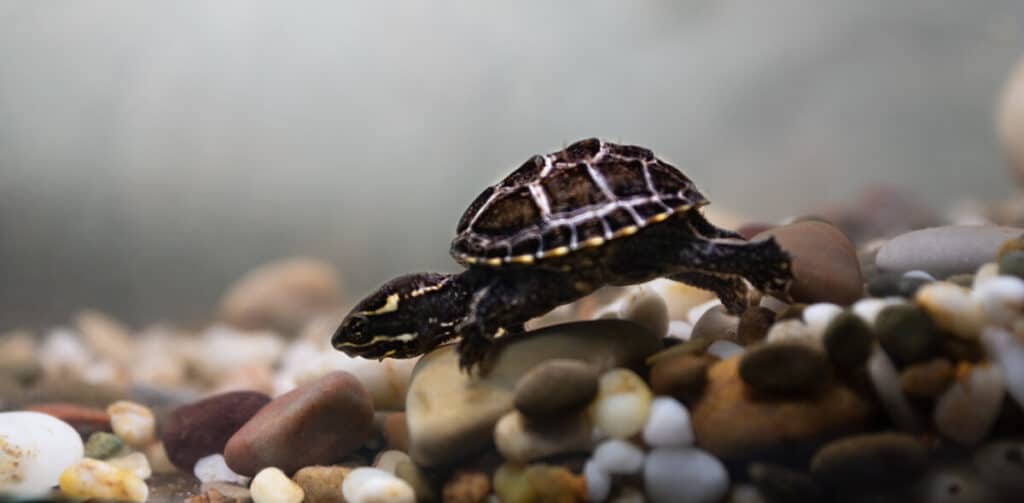
This is another beginner-friendly pet turtle that remains small even as it matures. The Common Musk turtle is also known as the Stinkpot turtle because its musk glands produce a stinky liquid when the turtle is threatened.
However, this should not worry you are they hardly do so in captivity.
Common Musk turtles don’t grow big as they have a shell length of between 3 and 5 inches. Males are bigger than females, but they are also relatively smaller than other turtle species. This turtle bears a pair of green or yellow lines that run from its nose tip to the neck. The shell color is dark grey and, at times, looks like black to camouflage with the mud in its surroundings. The shell tends to flatten out as the turtle matures.
A 20-gallon tank is enough if you are only keeping one due to the turtle’s small size. You will need a bigger size if you have multiple of them.
Since the turtle stays small, you would hardly need to change the tank size throughout the pet’s life. The water level should be kept low because they walk more than they swim. The level may be increased as they grow.
Having fine sand and pebbles in the tank will help the turtle to move around more comfortably. The turtle spends more time in water and basks occasionally. Therefore, it is ideal for providing the turtle with a basking rock.
Common musk turtles are considered to be exotic, and they are one of the rare turtle species. They can live for up to 50 years and cost about $50. It is important to note that they are fragile when young but not so after a few months. Although omnivorous in general, Common Musk turtles feed on more meat when in captivity.
3. Eastern Box Turtles

Box turtles are a common pet choice, and the Eastern box turtles are the most popular choice among those looking for pet box turtles. They are quite colorful, adorning a beautifully box-like pattern with yellowish and orange lines and dots on their shell.
The pattern helps them blend with their natural habitat, which is mainly grass or bushes. However, the colors start to fade as the turtle ages. Another unique feature is that the males have red eyes.
The Eastern Box turtle grows to a shell length of between 4 and 6 inches making them quite small. They are commonly found in the Eastern parts of the USA, as the name suggests.
These turtles like spending more time on moist land instead of water. As such, you should get a terrarium tank instead of an aquarium tank.
If indoors, the turtles will need a UVB basking light. Their environment should be kept warm and moist because they are highly susceptible to respiratory infections.
Since turtles are cold-blooded, they are unable to regulate their body temperature through metabolism and instead rely on external heat sources.
With a lifespan of about 40 years, this pet turtle can make a great lifetime companion, and you don’t have to worry that the reptile will outgrow its tank or become harder to manage because of its size.
They can be harder to manage than most other small turtles because they are sensitive and fragile when younger. The pet is a bit pricey as it costs between $140 and $260.
4. Spotted Turtle
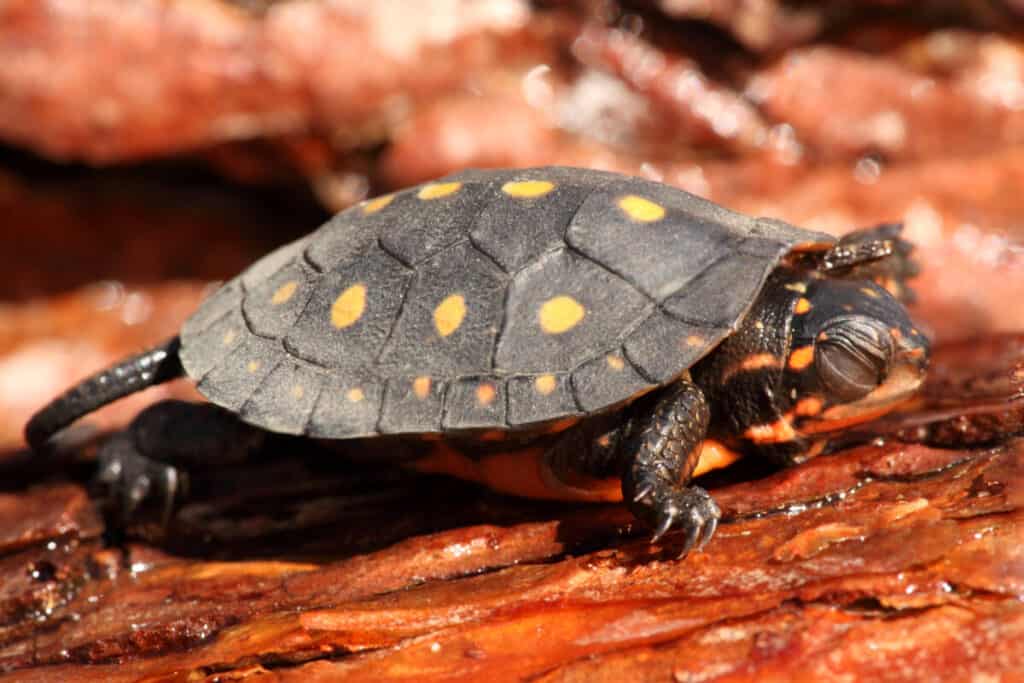
This is the smallest turtle species allowed to be reared in captivity. If you are looking for the tiniest pet turtle, then the spotted turtle is what you need.
They have a beautiful black shell with bright yellow spots. Some have yellow, red and orange colored spots on their bellies. They are easy to maintain in captivity and are a good choice for breeders because they are easy to breed.
Being one of the tiniest turtle species, the spotted turtle hardly measures 5 inches when fully grown. Juvenile spotted turtles are highly aquatic, while grown ones spend more time in moist fields. Although small, the spotted turtle is highly active and should be provided with a spacious enclosure.
A 20-gallon tank should be the minimum for an adult. Spotted turtles are also not good swimmers. It would be best to keep the water level at a depth where the turtle can get its head above the water surface without swimming.
When it comes to diet, the turtle feeds on more meat, but green leafy vegetables and fruits are also an important part of their diet.
The spotted turtle, also known as the Michigan Spotted turtle, can live for up to 100 years. You will be making a lifetime commitment by getting this turtle, as the turtle might outlive you. They are moderately priced as they cost between $75 and $100.
5. Diamondback Terrapin Turtle
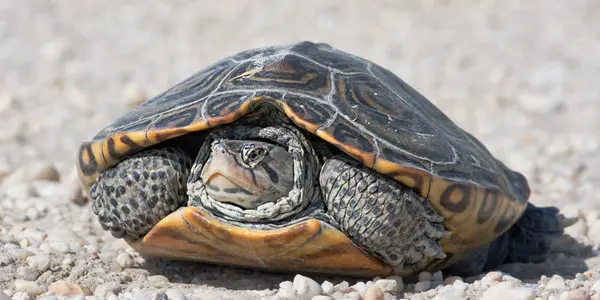
Diamondback turtles are great small pets, but they are not suitable for beginners. They are delicate and prone to fungal infections and shell diseases.
These turtles got their name from the diamond-like shapes on the upper part of their shell. The turtles have an attractive appearance with greyish or black shells.
They have spots and streaks that look like diamonds on their whole body, especially on their head, limbs and neck. Another unique feature of the diamondback turtle is that its upper lip is white.
Generally, male adult diamondback turtles measure 5 inches, but the females may grow a bit bigger. They are great swimmers and would require a big tank for this. A 70-gallon aquarium tank is ideal for a grown diamondback terrapin turtle. You should also have a UVB light to help the reptile synthesize Vitamin D in its shell. A heat source is also necessary to help the cold-blooded animal regulate its body temperature.
The turtle is omnivorous, and snails, worms, chopped fish as a good source of animal protein. If you have experience with pet turtles and have the time to provide a pet with tender care and attention, the beautiful diamond turtle will be a good choice. This pet turtle costs about $150 on average.
6. Male Reeve’s Turtle

Also known as the Chinese three-keeled pond turtle or Chinese pond turtle, this is one of the most sociable turtles in the category of turtles that stay small.
They sometimes enjoy human touch, which is uncommon among aquatic turtles. However, touching the turtle should only be done when necessary, as handling them for long can stress the pet.
Male Reeve’s turtles are smaller, and they attain a size of between 4 and 9 inches when fully grown. In the wild, the turtle is normally found in slow-flowing or stagnant water such as streams, lakes and ponds with a lot of vegetation and dry areas for basking.
Even though Reeve’s turtles are not as attractive as most of the other small turtles here, they are preferred by most pet owners because they maintain a docile demeanor and are charming.
Unlike most turtles, Reeve’s turtle has a shorter lifespan of about 20 years. They are easy to take care of and don’t require special care.
However, you should keep their shells in check as the turtle is prone to some diseases that manifest on the shell.
If you are looking for a pet turtle that stays small but you don’t want a lengthy commitment, the Reeve’s turtle is a good choice. They are also moderately priced, costing between $50 and $80.
7. Bog Turtle
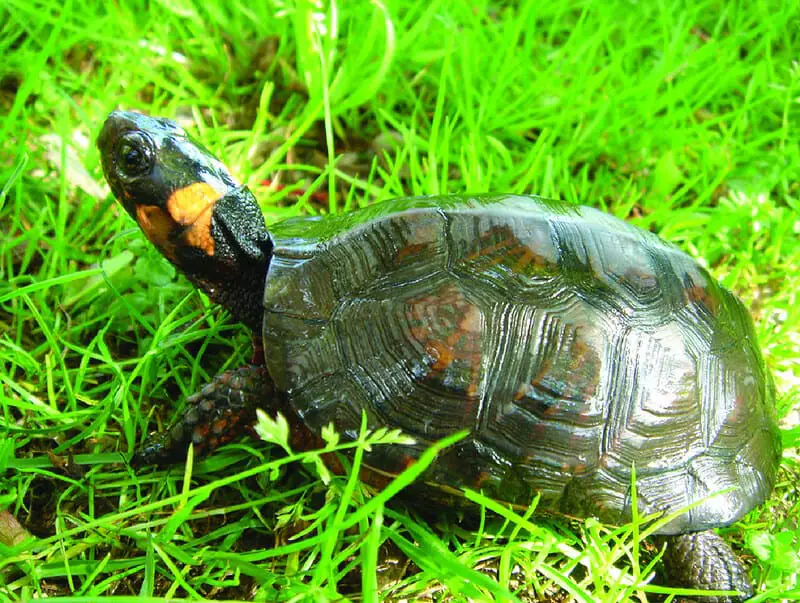
This very tiny turtle has an orange, yellowish patch on its head behind the eyes. The upper part of its shell is dark brown and, at times, appears to be black.
The shell also has yellowish plates, with that of the male being more doom-shaped and that of the female being flatter. Their wild habitat is in shallow wet, or muddy water bodies such as springs and swamps.
This turtle grows to a maximum length of between 3 inches and 4.5 inches. No bog turtle has been recorded as bigger than 4.5 inches since most of them only get to 3 inches when mature. The turtle requires ample space. For one turtle, you would require a 40-gallon tank.
Cleanliness is supposed to be optimal when keeping this turtle. The tank water temperature should be between 22 degrees and 26.5 degrees Celsius. If you keep both males and females, it is best to keep them in different tanks because male bog turtles become very territorial. The basking area should be conveniently placed with temperatures of between 29 degrees Celsius and 34.5 degrees Celsius.
They are omnivorous and mainly feed on small snakes, worms, frogs, salamanders, insects, fish and aquatic vegetation.
Green leafy vegetables and fruits such as strawberries are also highly recommended for this reptile. Calcium and Vitamin D are necessary for keeping the pet turtle healthy.
Bog turtles are considered to be under threat because of their demand in the black market. When buying a bog turtle, ensure that you use a reputable pet store or breeder that solely deals with turtles’ bred for captivity.
8. Desert Box Turtle
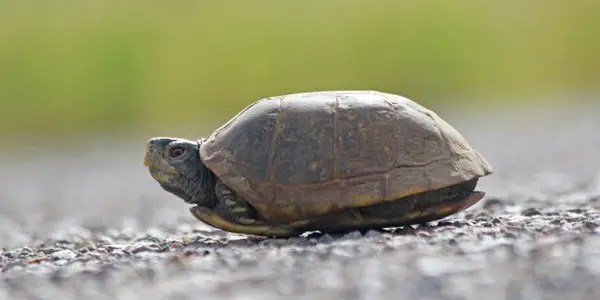
If you live in a dry environment, this might be a good choice for a small turtle. The desert box turtles don’t require high humidity. They are interesting animals to keep and watch as pets.
Desert box turtles grow to a length of 4 to 5 inches. The turtle lives for up to 50 years if taken care of well.
These turtles mainly feed on insects such as slugs, worms, and grasshoppers. You should avoid feeding the turtle with food high in protein as it can make your pet turtle obese.
These turtles are best placed in large outside enclosures or large spaces inside the house. Desert box turtles tend to break glass enclosures trying to reach the outside areas they can see. For this reason, wooden or Rubbermaid tubs are a better choice.
You should consider adding gravel, peat moss and sand in the enclosure to make the turtle more comfortable. A climbing rock is also a good addition. If the enclosure is outside, you should provide a shade where the desert box turtle can rest.
Although small and easy to maintain, the desert box turtle is an expensive species to buy. Their price can go as high as $400.
Benefits of Small Pet Turtles
Besides looking adorable, turtles that stay small have other benefits to both beginner and season pet turtle owners.
1. Easy to Feed
Generally, turtles are easier to feed compared to other reptiles. With a small turtle, the feeding is even easier.
The ratios are easy to follow depending on the turtle species, and the information is readily available.
Turtles eat easily, and there are a variety of readily available foods you can choose to include in their diet.
However, this doesn’t mean that you should feed your turtle with anything you come across. Some items such as chocolates, onions, and avocados are toxic to some turtle species. If you are not sure, research or ask your vet for guidance.
2. Affordable
Some small turtles are considered exotic and can cost above average. However, a large number of small turtles are quite affordable. In addition to being cheap to buy, they are also cheap to maintain. Because of their size, small turtles do not need large aquariums that you would buy for turtles that grow big.
Besides, the tanks don’t need a big filtration system that escalates the initial costs of keeping a pet turtle. The basic items are cheaper because they are smaller, and once you buy them, the only recurring expense will be annual vet check-ups, filters, food, supplements, and bulbs.
3. Easy to Manage
Small turtles involve less work compared to turtles that grow considerably big. Cleaning them is less demanding and can be done once a week. They are also fed every two to three days, making them less time-consuming. Since the turtles’ excretions are minimal, you have little to no substrate to clean.
Small turtles are also suitable for both apartments and houses, which is a luxury that large turtles don’t offer. With a small turtle, you only need to set the basking lamp’s timer and you are left with little work to do.
Tips for Buying and Keeping a Small Pet Turtle
The idea of getting a small pet turtle can be fascinating. We have also seen the benefits of choosing one. Some turtles require more care and attention than others.
Finding out how to choose the right one and how to comfortably live with one will make your experience with the pet turtle even more enjoyable.
· Know the Gender
When specifically looking for a small turtle, it is important to know the gender of the one you choose. This is because turtles vary in size based on their gender, with most female species being bigger than the males.
· Know Their Natural Habitat
Some turtles are aquatic, semi-aquatic while others are land turtles. Knowing the turtle’s natural habitat will help you determine the kind of tank, tank decorations, water level, diet, and how much space the pet would require.
· Where to Purchase
Some people keep turtles as an investment. These breeders are a good source of a pet turtle, especially if you are looking for exotic small turtle species. Since some turtle species are endangered, it is vital that you first verify that the breeder is legally selling the turtles before you purchase one.
You can also buy or adopt a turtle from a rescue center. These centers shelter abandoned turtles and those looking for a new home.
You might pay an adoption fee, but this is cheaper than what you would pay to a breeder. There are also pet stores that sell turtles.
You should not collect turtles from the wild. If you can no longer take care of your pet turtle, you should not release it into the wild. Turtles that have grown in captivity would struggle to survive in the wild. Instead, take the pet to a rescue center or make arrangements to have the pet rehomed.
· Diet
A majority of turtles are omnivorous, meaning that they eat both plants and meat. Juvenile turtles require more meat, and the ratio of meat to plants reduces as the turtle matures. A balanced diet is vital to the turtles’ health.
If you have a small aquatic turtle, it should be fed in water to help it swallow food. If you are not sure on what to feed your turtle, consult the vet or research.
Generally, most turtles get their meat proteins from crayfish, insects and slugs.
They also feed on green leafy vegetables such as broccoli, lettuce, kale and spinach.
Supplements are also crucial as they make up for the vitamins and minerals the food is low in. If you want your small turtle to remain in optimal health, supplements should be a mandatory part of the diet.
Treating turtles’ illnesses are expensive, and having a balanced diet can help prevent this.
Conclusion
Small turtles are cute and can make a great lifelong companion because of their long lifespan. They are also easy to manage, more affordable, and easier to feed, making them great for people in apartments where space is limited.
However, just because small turtles are easier to take care of doesn’t mean you abandon them for days without care. They are still a significant responsibility because you need to feed them every two to three days, change the water weekly, and clean the tank from time to time.
Some are also more vulnerable than others. If you have different small turtle species, they should be kept in separate tanks.
If you are looking for a pet turtle, we trust that this has helped you narrow down your choices and also helped you prepare for the new member of your family.
For a beginner pet turtle owner, we suggest you start with the Common Musk turtle. This species is easier to take care of and is less demanding.
